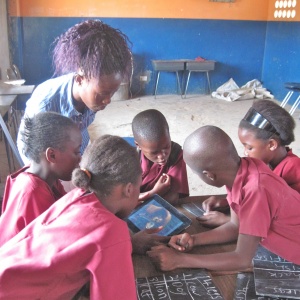OER4Schools/Classroom assistants: Difference between revisions
No edit summary |
No edit summary |
||
| Line 5: | Line 5: | ||
How do you think an older child (e.g. grade 8 or 9) could help in a grade 5 class? In some innovative European schools, cross- or multi-grade teaching takes place, not out of necessity, but because it makes pedagogical sense. Older students can benefit from having to explain things to younger students, while younger students may surprise older students with how they think about things. | How do you think an older child (e.g. grade 8 or 9) could help in a grade 5 class? In some innovative European schools, cross- or multi-grade teaching takes place, not out of necessity, but because it makes pedagogical sense. Older students can benefit from having to explain things to younger students, while younger students may surprise older students with how they think about things. | ||
Sometimes a student | Sometimes a student can even explain something better to peers than the teacher can! In Unit 3, Session 1 (video: new Abel clip 4), we saw how Abel solicited the help of two older boys in his mixed age (11-16) class when he himself had had difficulty in helping a group of students to understand how to find 'area' and 'perimeter' of a rectangle using GeoGebra software. | ||
In an African context, many schools operate in two (or more) shifts. This might mean that (e.g.) Grade 5 is taught in the morning, while Grade 7 is taught in the afternoon. This situation, born out of necessity, could be turned around to really benefit teaching and learning at your school. This week, we are asking you to conduct an experiment to see whether this can work at your school. In your homework today, we suggest that you each try to recruit two or three “classroom assistants” from a higher grade to help you with teaching in your grade. | In an African context, many schools operate in two (or more) shifts. This might mean that (e.g.) Grade 5 is taught in the morning, while Grade 7 is taught in the afternoon. This situation, born out of necessity, could be turned around to really benefit teaching and learning at your school. This week, we are asking you to conduct an experiment to see whether this can work at your school. In your homework today, we suggest that you each try to recruit two or three “classroom assistants” from a higher grade to help you with teaching in your grade. | ||
Latest revision as of 11:25, 14 January 2015
| Resource details | |
| Title | Classroom assistants |
| Topic | |
| Teaching approach | |
| Learning Objectives | |
| Format / structure | |
| Subject | |
| Age of students / grade | |
| Table of contents | |
| Additional Resources/material needed | |
| Useful information | |
| Related ORBIT Wiki Resources | |
| Other (e.g. time frame) | |
| Files and resources to view and download | |
| Acknowledgement | This resource is part of the OER4Schools programme. |
| License | |
How do you think an older child (e.g. grade 8 or 9) could help in a grade 5 class? In some innovative European schools, cross- or multi-grade teaching takes place, not out of necessity, but because it makes pedagogical sense. Older students can benefit from having to explain things to younger students, while younger students may surprise older students with how they think about things.
Sometimes a student can even explain something better to peers than the teacher can! In Unit 3, Session 1 (video: new Abel clip 4), we saw how Abel solicited the help of two older boys in his mixed age (11-16) class when he himself had had difficulty in helping a group of students to understand how to find 'area' and 'perimeter' of a rectangle using GeoGebra software.
In an African context, many schools operate in two (or more) shifts. This might mean that (e.g.) Grade 5 is taught in the morning, while Grade 7 is taught in the afternoon. This situation, born out of necessity, could be turned around to really benefit teaching and learning at your school. This week, we are asking you to conduct an experiment to see whether this can work at your school. In your homework today, we suggest that you each try to recruit two or three “classroom assistants” from a higher grade to help you with teaching in your grade.
![]() Whole class dialogue (10 min): Discussion about classroom assistants. Here are some points that you need to discuss:
Whole class dialogue (10 min): Discussion about classroom assistants. Here are some points that you need to discuss:
- What is the benefit of this to your class?
- What do you need to discuss with the head teacher before you can recruit some students from a higher grade to help? How often is it reasonable for the older students to come?
- What is the benefit for the higher grade students? What incentive is needed for those students to want to come and help in your class? How can you make sure that those students stay engaged in the programme? For instance, you might want to set up a “computer club” for those Grade 8 and 9 students who help out in the lower grades.
- How will the parents of those students react to this? What do you (or the headteacher) need to say to those parents? Do you need to write a letter, that can be given to the parents?

